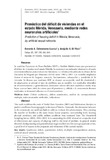| dc.rights.license | http://creativecommons.org/licenses/by-nc-sa/3.0/ve/ | |
| dc.contributor.author | Colmenares Lacruz, Gerardo Augusto | |
| dc.contributor.author | Gil Ruiz, Annjulie A. | |
| dc.date.accessioned | 2011-05-13T21:35:22Z | |
| dc.date.available | 2011-05-13T21:35:22Z | |
| dc.date.issued | 2011-05-13T21:35:22Z | |
| dc.identifier.uri | http://www.saber.ula.ve/handle/123456789/33071 | |
| dc.description.abstract | Se combina Funciones de Bases Radiales (RBF) y Análisis Multivariante para pronosticar el déficit de viviendas en el estado Mérida. Se construyó un
indicador alternativo al usado convencionalmente para evaluar este fenómeno. La información primaria se obtuvo de las Encuestas de Hogares por Muestreo
(EHM) entre 1994 y 2005. Las variables empleadas fueron el número de hogares, tenencia, hacinamiento, adecuación y condición de la vivienda. Se destaca que
mediante RBF se alcanzó un aceptable nivel de efectividad y de adaptación: se adecuó al tipo de problema que se modeló. Los resultados obtenidos en el
entrenamiento y generalización alcanzaron valores del error cuadrático medio muy bajos, con un buen nivel de acierto para el pronóstico y, debido a la
consistencia de estos resultados, se demostró robustez en el entrenamiento. | es_VE |
| dc.language.iso | es | es_VE |
| dc.rights | info:eu-repo/semantics/openAccess | |
| dc.subject | Déficit cualitativo | es_VE |
| dc.subject | Déficit cuantitativo | es_VE |
| dc.subject | Análisis de correspondencia múltiple | es_VE |
| dc.subject | Redes neuronales artificiales | es_VE |
| dc.subject | Indicadores | es_VE |
| dc.title | Pronóstico del déficit de viviendas en el estado Mérida, Venezuela mediante redes neuronales artificiales | es_VE |
| dc.title.alternative | Prediction of insufficient housing supply at Mérida, Venezuela by artificial neural networks | es_VE |
| dc.type | info:eu-repo/semantics/article | |
| dc.description.abstract1 | This work combines the tools of Radial Basis Function (RBF) and Multivariate Analysis to predict insufficient housing supply in the state of Merida,
Venezuela. An alternative indicator to the commonly one used was built in order to evaluate this phenomenon. Data covering the number of families at the
same house, house property, overcrowding level, housing physical condition, and public utilities condition were extracted from The Household Sampling Survey
(HSS), 1994-2005. It is outstanding that RBF showed an acceptable level of effectiveness and capacity of adapting itself to this kind of problem. In
general, results obtained during training and generalization stages reached very low average quadratic errors, a good level of success in the prognosis and
robustness of the trained models. | es_VE |
| dc.description.colacion | 109-140 | es_VE |
| dc.description.email | gcolmen@ula.ve | es_VE |
| dc.description.email | kannjulie@hotmail.com | es_VE |
| dc.description.frecuencia | semestral | es_VE |
| dc.identifier.depositolegal | 198702me336 | es_VE |
| dc.subject.facultad | Facultad de Ciencias Económicas y Sociales | es_VE |
| dc.subject.institutoinvestigacion | Instituto de Investigaciones Económicas y Sociales (IIES) | es_VE |
| dc.subject.keywords | Qualitative deficit | es_VE |
| dc.subject.keywords | Quantitative deficit | es_VE |
| dc.subject.keywords | Multiple correspondence analysis | es_VE |
| dc.subject.keywords | Artificial neural networks | es_VE |
| dc.subject.keywords | Scores | es_VE |
| dc.subject.publicacionelectronica | Revista Economía | es_VE |
| dc.subject.seccion | Revista Economía: Artículos | es_VE |
| dc.subject.thematiccategory | Ciencias Económicas y Sociales | es_VE |
| dc.subject.tipo | Revistas | es_VE |
| dc.type.media | Texto | es_VE |


